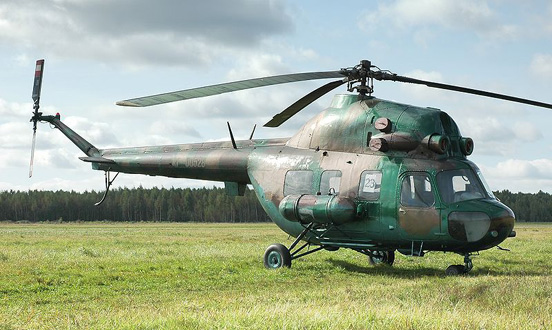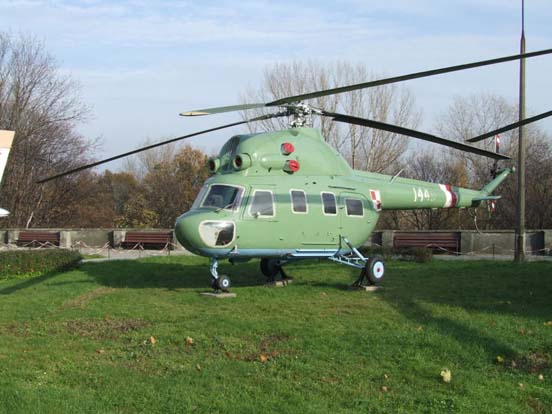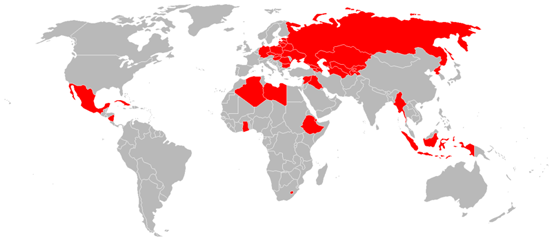 |
|
By
Wikipedia,
the free encyclopedia,
http://en.wikipedia.org/wiki/Mil_Mi-2
The Mil Mi-2 (NATO reporting name is "Hoplite") is a small, lightly armored transport helicopter that could also provide close air support when armed with 57 mm rockets and a 23 mm cannon.
Design and development
The Mi-2 was produced exclusively in Poland, in the WSK "PZL-Świdnik" factory in Świdnik. Production ended in 1985 after about 7,200 were made.
The first production helicopter in the Soviet Union was the Mil Mi-1, modelled along the lines of the S-51 and Bristol Sycamore and flown by Mikhail Mil's bureau in September 1948. During the 1950s it became evident, and confirmed by American and French development, that helicopters could be greatly improved with turbine engines. S. P. Isotov developed the GTD-350 engine and Mil used two of these in the far superior Mi-2. After initial development at the Mil bureau (Soviet designation V-2) this was transferred to Poland in 1964, after the first Swidnik-built example had flown. WSK-Świdnik has since delivered many hundreds, possibly one-third of them to military customers, and developed plastic rotor blades and the wide-body Mi-2M seating 10 passengers instead of eight. Most typical role kits include four stretchers, as air ambulance, or aerospraying or cropdusting device.
In Poland, there were also developed several specialized military variants, first of all support or reconnaissance ones, with 23 mm autocannon, machine guns and/or two 57 mm rocket pods, four 9K11 Malyutka anti-tank missiles or Strela-2 AA missiles.
Operational history
It was first introduced into the Soviet Air Force in 1965. The Mi-2 is used by mainly former Soviet and Eastern Bloc countries, although it is used by Germany, Mexico and Myanmar as well.
Most of armed Mi-2 variants were used by Poland. Some were also used by the East Germany (with machine gun and unguided rocket armament only).
Variants
 | |
Mi-2 in Borki, Tver region, Russia |
 | |
Mi-2P exhibited in Polish Army Museum in Warsaw. Helicopter in markings of the 42 eskadra lotnicza MSWiA based at Warszawa-Bemowo airfield. |
- V-2
- First prototype.
- V-2V
- Armament prototype.
- Mi-2 Platan
- Aerial minelayer version.
- Mi-2A
- Mi-2B
- Upgraded export version for the Middle East, fitted with improved systems and navigational aids.
- Mi-2Ch Chekla
- Chemical reconnaissance / smokescreen layer version.
- Mi-2D Przetacznik
- Aerial command post equipped with R-111 radio.
- Mi-2FM
- Survey version.
- Mi-2P
- Passenger / cargo version, with accommodation for 6 passengers.
- Mi-2R
- Agricultural version.
- Mi-2RL
- Land rescue/ambulance version.
- Mi-2RM
- Sea rescue version equipped with electric winch for two people and dropped rafts.
- Mi-2Ro
- Reconnaissance version equipped with cameras.
- UMi-2Ro
- Reconnaissance trainer version.
- Mi-2RS Padalec
- Chemical and biohazard reconnaissance version.
- Mi-2S
- Air ambulance version, equipped to carry four litters, plus an attendant.
- Mi-2Sz
- Dual-control training version.
- Mi-2T
- Cargo/utility version.
- Mi-2U
- Dual-control training version.
- Mi-2US
- Armed version fitted with a fixed 23mm NS-23 cannon, 4 x 7,62mm PKT machine gun pods and optional cabin PK machine gun.
- Mi-2URN Żmija ('Viper')
- Armed reconnaissance variant armed with a fixed 23mm NS-23 gun and two 16x57mm S-5 unguided rocket pods Mars-2. Optional 7,62mm PK machine gun window-mounted.
- Mi-2URP Salamandra ('Salamander')
- Gunship and anti-tank variant, armed with 23mm NS-23 gun, optional window-mounted 7,62mm PK machine gun, and 4x AT-3 Sagger (9M14M Malutka) wire-guided missiles on external weapons racks and 4x additional missiles in the cargo compartment.
- Mi-2URP-G Gniewosz
- Mi-2URP with additional 4x AA missiles Strzała-2 (Strela 2) in two Gad rocket launchers.
- Mi-2 Plus
- Upgraded Mi-2 with uprated GTD-350W2 engines, all-composite rotor blades, new avionics and some other modifications.
- Mi-3
- Planned Mi-2 derivative that lacked suitable engines for the program to continue.
Operators
 | |
Mi-2 operators |
 Afghanistan Afghanistan- Unconfirmed reports of six in service around 1982 and 1983.
 Albania Albania
 Algeria Algeria Armenia Armenia- Only 2-3 are kept in flyable condition, for training purposes.
 Azerbaijan Azerbaijan Belarus Belarus Cuba Cuba
 Czech Republic Czech Republic
 Czechoslovakia Czechoslovakia
 Djibouti Djibouti Estonia Estonia
- 2 in Estonian Aviation Museum
 Ethiopia Ethiopia Cambodia Cambodia Georgia Georgia East Germany East Germany
East Germany operated 48 helicopters, in 1972-1990, also in armed variant
 Germany Germany
 Ghana Ghana Hungary Hungary
 Indonesia Indonesia
- Indonesian Air Force acquired their Mi-2 in 1961 and used during the preparation of Operation TRIKORA in 1962 in Western New Guinea (now Papua and Papua Barat). This helicopter were largely grounded in 1969 and removed from service in 1970 (one of this helicopter saved in Museum Satria Mandala, Jakarta)
- Indonesian Navy (TNI-AL) bought again 16 Mi-2 (old variant of Mi-2) in 2003. But, there are only 3 helicopters remain operational (but all of them can't fly) and 13 others haven't arrived due to problems with Indonesian Navy's agencies .
- Indonesian Police (Polisi Lintas Udara) also operates Mi-2 helicopters. All of the helicopters are old variants of Mi-2 .
 Iraq Iraq
 Latvia Latvia Lesotho Lesotho Libya Libya
 Lithuania Lithuania
 Mongolia Mongolia
 Mexico Mexico Myanmar Myanmar
 Nicaragua Nicaragua North Korea North Korea
 Poland Poland
 Peru Peru
 Russia Russia
 Slovakia Slovakia Soviet Union Soviet Union- Passed on to successor states.
 Syria Syria
 Turkey Turkey
 Ukraine Ukraine
 United States United States
- Cold War Air Museum (CWAM) operates 4 Mi-2s from its Museum at Lancaster Airport (Texas) just south of Dallas, Texas.
- U.S. Army is said to have a few Mi2 Hoplites for training purposes located at Fort Bliss, Texas. The Hoplite is used to train pilots in Soviet aircraft before moving to larger Soviet helicopters such as the Mi24.
- U.S. FAA registry lists 13 privately owned Mi-2s operated by civilians. Only 4 of the 13 have Airworthiness Certificates.
 Yugoslavia Yugoslavia
Specifications (Mi-2T)
General characteristics
- Crew: One
- Capacity: 8 passengers or 700 kg (1,540 lb) internal, 800 kg (1,760 lb) external cargo
- Length: 11.9 m (39 ft 4 in)
- Rotor diameter: 14.6 m (47 ft 11 in)
- Height: 3.7 m (12 ft 2 in)
- Disc area: 167 m² (1,797 ft²)
- Empty weight: 2,372 kg (5,218 lb)
- Loaded weight: 3,550 kg (7,810 lb)
- Max takeoff weight: 3,700 kg (8,140 lb)
- Powerplant: 2× PZL GTD-350 turboshafts, 298 kW (400 shp) each
Performance
See also
Related development
Comparable aircraft
External links
Text from Wikipedia is available under the Creative Commons Attribution/Share-Alike License; additional terms may apply.
Published in July 2009.
Click here to read more articles related to aviation and space!
|
 |



